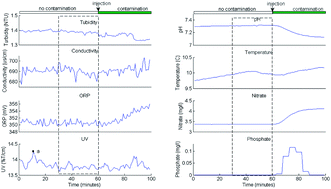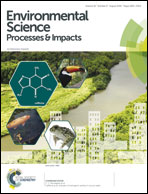Contamination event detection using multiple types of conventional water quality sensors in source water†
Abstract
Early warning systems are often used to detect deliberate and accidental contamination events in a water system. Conventional methods normally detect a contamination event by comparing the predicted and observed water quality values from one sensor. This paper proposes a new method for event detection by exploring the correlative relationships between multiple types of conventional water quality sensors. The performance of the proposed method was evaluated using data from contaminant injection experiments in a laboratory. Results from these experiments demonstrated the correlative responses of multiple types of sensors. It was observed that the proposed method could detect a contamination event 9 minutes after the introduction of lead nitrate solution with a concentration of 0.01 mg L−1. The proposed method employs three parameters. Their impact on the detection performance was also analyzed. The initial analysis showed that the correlative response is contaminant-specific, which implies that it can be utilized not only for contamination detection, but also for contaminant identification.


 Please wait while we load your content...
Please wait while we load your content...